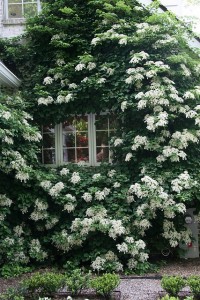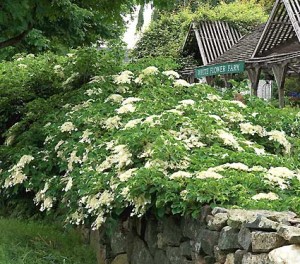Climbing Hydrangeas are rarely associated with their shrubby cousins.These hefty vines occupy a space in the garden all their own.These vigorous climbers can reach a height (or length) of over 40 feet and produce large white flower heads that have a similar structure to lace cap hydrangea flowers. Garden designers use climbing Hydrangeas to add drama and vertical interest to shady spots in the landscape.
Just give this plant a sturdy structure to grow on and lots of space and you won’t be disappointed!
Getting the Best out of Your Climbing Hydrangea
If you want to add some vertical (or even horizontal) interest to your landscape, there is almost no climbing vine more dramatic than the climbing Hydrangea.It is not widely planted, so it definitely turns heads.Its large features give it a structural and architectural feel that you wouldn’t get out of a wisteria or clematis vine.The trick to using climbing Hydrangeas is finding the right spot.They like shady areas and need consistent moisture when getting established.
These giant climbers will grow fast once established, but it may take a year or two for them to get comfortable with their spot.So, don’t be discouraged if your climbing Hydrangea doesn’t grow much the first year.You will also need to be patient for flowering.
Some vines take up to 5 years to flower, so it’s best to consider this plant an investment for the future.The good news is that they are attractive even without flowers.Please don’t let all this talk of patience and time discourage you.Climbing Hydrangeas are well worth the time investment.
Climbing Hydrangeas can be grown vertically on a structure or wall, or can creep horizontally along the ground or a stone wall.If you are going to let your climbing Hydrangea climb, be sure to give it a solid structure to climb on.This can become a very heavy plant with age!We do not suggest letting a climbing Hydrangea climb the side of a house unless it has a brick or stone surface.Even then, never let the Hydrangea climb onto a shingled roof!If you are using a pergola or arbor, make sure it’s a sturdy one.Climbing Hydrangeas are sometimes planted at the base of tall trees and allowed to climb up.
There is virtually no maintenance required for climbing Hydrangeas.Just trim as necessary if you want to keep the vine to a certain size, otherwise just let it grow!
The bottom line with climbing Hydrangeas is that patience pays off.Find an appropriate spot, plant it and give it some extra water the first season, then forget it for a year or two.Your patience will be rewarded with a stunning show for years to come.





